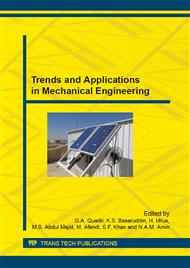[1]
I. Wender, Reaction for Synthesis Gas, Fuel Process Technol, 48: 189, (1996).
Google Scholar
[2]
M. Moliere, Benefiting from the Wide Fuel Capability of Gas Turbines: A review of Application Opportunities, ASME Turbo Expo 2002: Power for Land, Sea, and Air , vol. 1, pp.227-233, Amsterdam , The Netherlands, June, (2002).
DOI: 10.1115/gt2002-30017
Google Scholar
[3]
A.F. Tabatabaei and M.A. Soroudi, A Kinetic Study of Syngas Combustion Characteristics for Gas Turbine Applications, the Seventh Mediterranean Combustion Symposium, Italy, September, (2011).
Google Scholar
[4]
A. D. Pascale, M. Fussi, A. Peretto, Numerical Simulation of Biomass Derived Syngas Combustion in a Swirl Flame Combustor, Proceedings of ASME Turbo Expo 2010: Power for Land, Sea and Air, vol. 1, pp.571-582, Glasgow, UK, June, (2010).
DOI: 10.1115/gt2010-22791
Google Scholar
[5]
M.C. Drake, and R.J. Blint, Thermal NOx in stretched laminar opposed-flow diffusion flames with CO/H2/N2 Fuel, Combustion and Flames, vol. 76(2), pp.151-167, (1989).
DOI: 10.1016/0010-2180(89)90064-3
Google Scholar
[6]
J. Park, J.G. Choi, S.I. Keel, and T.K. Kim, Flame structure and NO emissions in gas combustion of low calorific heating value, International Journal of Energy Research, vol. 27, pp.1339-1361, (2003).
DOI: 10.1002/er.955
Google Scholar
[7]
R.W. Schefer, D.M. Wicksall and A.K. Agrawal, Combustion of hydrogen enriched methane in a lean premixed swirl stabilized burner, Proceedings of the Combustion Institute, vol. 29(1), pp.843-851, (2001).
DOI: 10.1016/s1540-7489(02)80108-0
Google Scholar
[8]
S. Som, A.I. Ramı´rez, J. Hagerdorn, A. Saveliev, and S.K. Aggarwal, A numerical and experimental study of counterflow syngas flames at different pressures, Fuel 87, p.319–334, (2008).
DOI: 10.1016/j.fuel.2007.05.023
Google Scholar
[9]
S.G. Davis, A.V. Joshi, H. Wang, F. Egolfopoulos, An optimized kinetic model of H2/CO combustion , , Proceedings of the Combustion Institute, 30 (2005), p.1283–1292.
DOI: 10.1016/j.proci.2004.08.252
Google Scholar
[10]
M.A. Mueller, R.A. Yetter, F.L. Dryer, Flow reactor studies and kinetic modeling of the H2/O2/NOx and CO/H2O/O2/NOx reactions, International Journal of Chemical Kinetics, 31(10), pp.705-724, (1999).
DOI: 10.1002/(sici)1097-4601(1999)31:2<113::aid-kin5>3.0.co;2-0
Google Scholar
[11]
H. Hasini, N.H. Shuaib, and A.F.W. A Wan, CFD Analysis of Temperature Distribution in Can Type Combustor Firing Synthetic Gas, Applied Mechanics and Materials, Vol. 393 (2013), pp.741-746, (2013).
DOI: 10.4028/www.scientific.net/amm.393.741
Google Scholar


